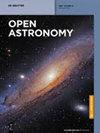Application of clustering algorithm to wide stellar pairs for unsupervised search of parts of disrupting clusters
IF 0.5
4区 物理与天体物理
Q4 ASTRONOMY & ASTROPHYSICS
引用次数: 4
Abstract
Abstract We introduce the application of the clustering algorithm to the preliminary compiled list of probable wide pairs of co-moving stars. The main aim of such development is a possibility of unsupervised blind search of coeval loose stellar structures over significant regions in space. Using Gaia EDR3 data, we investigated the application of the method to nearby region hosting recently discovered loose structures – tidal tails of Coma Ber star cluster and a nearby stellar group named Group X. We compare the results of straightforward clustering of stellar data with results of using our method with varying parameters. We then compare the results of our method to the recent results of the two groups of authors who independently discovered the discussed structures. We find parameters allowing the method to find the full scope of distributed stellar groups without preliminary knowledge of their characteristics. It decreases the risk of false positive clustering and improves the ability to discover loose stellar groups, in comparison with the application of clustering algorithm to the individual stars. Further we obtain a refined dataset of probable members of both stellar groups and independently obtain their ages (700 ± 70 Myr and 450 ± 100 Myr) and space velocities ((U,V,W) = (8.63 ± 0.13, 6.63 ± 0.20, 6.65 ± 0.95) km/s for Coma Ber star cluster, and (U,V,W) = (7.70 ± 0.12, 3.27 ± 0.45, 5.69 ± 0.80) km/s for Group X). Our results are in very good agreement with those of previous investigators.聚类算法在大范围恒星对中的应用,用于无序星团部分的无监督搜索
摘要本文介绍了聚类算法在可能宽对同动星初步编制列表中的应用。这种发展的主要目的是在空间的重要区域进行无监督的盲搜索。利用Gaia EDR3数据,我们研究了该方法在附近区域的应用,该区域包含最近发现的松散结构-彗发Ber星团的潮汐尾和附近的一个名为x的恒星群。我们比较了使用我们的方法在不同参数下对恒星数据进行直接聚类的结果。然后,我们将我们的方法的结果与独立发现所讨论的结构的两组作者最近的结果进行比较。我们找到了一些参数,使该方法能够在不了解其特征的情况下找到分布恒星群的全部范围。与将聚类算法应用于单个恒星相比,它降低了误报聚类的风险,提高了发现松散恒星群的能力。进一步,我们获得了两个恒星群可能成员的精细化数据集,并独立获得了它们的年龄(700±70 Myr和450±100 Myr)和空间速度((U,V,W) =(8.63±0.13,6.63±0.20,6.65±0.95)km/s, (U,V,W) =(7.70±0.12,3.27±0.45,5.69±0.80)km/s),我们的结果与之前的研究人员的结果非常一致。
本文章由计算机程序翻译,如有差异,请以英文原文为准。
求助全文
约1分钟内获得全文
求助全文
来源期刊

Open Astronomy
Physics and Astronomy-Astronomy and Astrophysics
CiteScore
1.30
自引率
14.30%
发文量
37
审稿时长
16 weeks
期刊介绍:
The journal disseminates research in both observational and theoretical astronomy, astrophysics, solar physics, cosmology, galactic and extragalactic astronomy, high energy particles physics, planetary science, space science and astronomy-related astrobiology, presenting as well the surveys dedicated to astronomical history and education.
 求助内容:
求助内容: 应助结果提醒方式:
应助结果提醒方式:


